#jewishjanuary
Text
Beyond Blue and White: a Jewish Holiday Resource for Artists
If I show you this color palette, you know exactly what holiday it refers to, right?

Image: a palette of red, green, gold, and white.
How about these?

Image: a palette of pastel blue, purple, pink, and bright yellow.

Image: a palette of orange, black, purple, and green.
American? Try these:

Palette: red, white, and blue
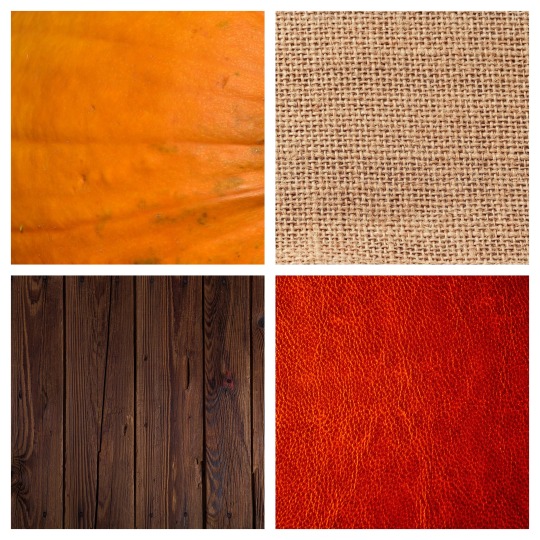
Palette: orange, tan, red, and brown
Now, I was thinking about this a lot this year, at various times. It came up when I tried to decorate my dining room for Rosh Hashanah but couldn’t find anything I like that really fit. It was still on my mind when the jack-o’-lanterns and bats appeared and then disappeared again under an onslaught of red and green. And then the Chanukah sections.

Palette: four shades of blue.
The Chanukah sections.

Palette: nine shades of blue.
The Chanukah.

Palette: nine shades of blue.
Sections.

Image: photos of the Chanukah displays from nine stores. They are entirely royal blue with white accents, and occasional baby blue or silver.
Seriously, people. I can’t even. And that’s what the war-on-Christmas crowd is mad about? That’s what we get, and they’re mad about it? Some of those items are just Christmas things in blue, with “Hanukkah” written on them. And they’re mad about it?
Of course, Chanukah, despite being a minor holiday on our calendar, is one of only two holidays that get dedicated displays: Chanukah because it falls near Christmas, and Passover because supermarkets did eventually figure out the astounding scale of food we buy, and learn to plan accordingly. And most of the food in the passover displays is, well, food. But don’t worry, supermarket marketing designers know what color to use!

Image: photos of the Passover displays in six grocery stores. The signs defining the displays are the same range of blues as the Chanukah displays above.
Yeah, that last one just put the flag of Israel near some grape juice and called it a day, but we’re just going to John Mulaney on past it right now, because this is a post about a different topic.
Now, I only started being active on Tumblr recently, and I’ve never been much involved in fan works, so maybe it’s like this every year, but in the lead-up to the winter holiday season I saw a lot of posts calling for artists--for fan artists in particular--to not reduce Jewish characters and Jewish imagery to Chanukah in opposition to Christmas, to remember our other holidays exist, to remember we exist outside of the shadow of Christmastime. And they’re right. But if you mean well but aren’t immersed in Jewish culture, how is that to be accomplished? How, practically, do you do that? What do Jewish holidays look like?
For me at least, most Jewish holidays have aesthetic palettes as distinctive as any of the ones above. My taste may not be universal, but in this post I would like to share some very basic color palettes for a few of the most significant Jewish holidays, a few notes on activities people might expect to take part in (including whether or not we are prohibited to work on that day), and some basic visual symbols to use as well.
As is common with posts of this type I would like to specify that while I welcome non-Jews to use this post to enrich your depictions of Jewish characters and occasions, you are not invited to use this in a Christian context, in a Messianic “Jewish” context (so-called Messianic “Judaism” is a culturally-appropriative Christian missionary movement, and is viewed by the Jewish community in general as predatory and offensive), in a context that assigns Jewish observance to Christian characters in the name of Christian practice, or in a context that ascribes contemporary Jewish practice to a divine Jesus. It is not appropriate to use contemporary Jewish symbols or practice to “deepen your relationship with Jesus” or to add Jewish “flavor” to your Christian practice. Thank you for respecting this request.
That said, let’s get to it. Presented in order of the Jewish year:
Rosh Hashanah
Jewish New Year. Two days, in early autumn. Since the Jewish calendar is not synced to the secular calendar, this can fall anywhere from the last days of August to early October. Yes, we have our own calendar, and we do follow it. Rosh Hashanah may move around September, but it always falls on the first day of Tishrei. It’s also worth noting that on the Jewish calendar the new date begins at sunset, not midnight.
This is one of our holidays on which working is prohibited. It is also the first of what are known as the High Holidays. Many of us spend a large portion of the day in services at a synagogue--including many who are not regular attendees year-round--but this is also a major occasion for hosting large festive meals and get-togethers with family and friends.
This is not a good day to schedule parent-teacher conferences.
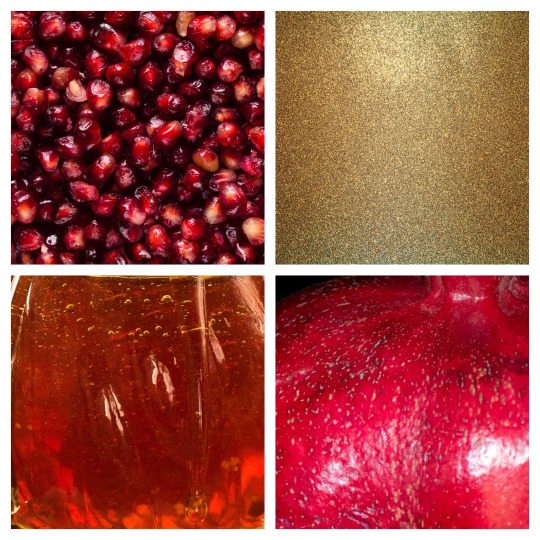
Palette: red and gold, honey tones.
Relevant symbols include: the shofar, which is sounded during the holiday; apples and honey, eaten “for a sweet new year;” a whole fish, eaten “to be like the head and not like the tail;” round challah loaves to acknowledge the cyclical nature of the calendar; crown imagery, to acknowledge God’s sovereignty; pomegranates, which echo the crown theme and are said to have as many seeds as there are commandments in the torah (613). Books, both prayer books called Machzorim (singular Machzor) which we use during the holiday service, and the Book fo Life, in which God is said to be writing out the next year’s fates during this time.
Yom Kippur
Ten days after Rosh Hashanah, Yom Kippur is often called the Day of Repentance in English, but the Hebrew name of the holiday translates better as “Day of absolution.” Judaism doesn’t have the same relationship to the concept of “sin” that Christianity has: while Christianity revolves around an idea that humans are inherently sinful and only the death of their human god guy can fix this innate state of being, Judaism did not adopt this view and continues to believe that humans are essentially good, but sometimes make mistakes. In the days between Rosh Hashanah and Yom Kippur, we are expected to apologize sincerely and try to make restitution to anyone we might have hurt in the past year.
On Yom Kippur, Jewish adults (who are medically/psychologically able to do so without harm) do not eat or drink from sunset to sunset. We wear white, often including a kittel, the same plain white robe that Jews are buried and often married in, and including our tallitot, prayer shawls, which are otherwise only worn during morning services. We avoid wearing leather shoes (some also avoid wearing leather belts or carrying leather purses). The prohibition on working on this day is observed even by many Jews who aren’t strict about it at other times. This is the other holiday that comprises the High Holidays.
It is not a good day to schedule a Little League game.
During this solemn time we spend most of the day in the synagogue. The service notably includes a communal confession: we do not confess our personal wrongdoings as individuals, but instead recite an acrostic poem of deeds that one of us might have committed, somewhere in the worldwide Jewish community. In this moment, we accept that all of us are one community, those who have killed or assaulted, those who have embezzled and perjured, those who have polluted or discriminated, those who have refused to donate what they could have to causes of justice, those who have hurt others’ feelings, who have caused social drama, who have cheated on partners or on quizzes or at Candyland. Communally, in unison, in centuries-old poetry, we ask for clemency and commit to doing better.
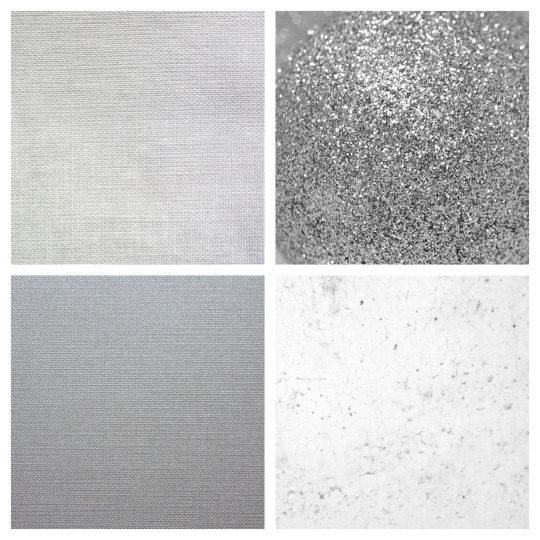
Palette: White and silver.
Relevant symbols include: Shofars and Machzors, as with Rosh Hashanah; crowns, likewise; white, to symbolize both purity and humility; the Book of Life, in which God is said to be sealing our fate for the year after spending the past week considering it; imagery of closing gates, as the last service of the day invokes the image of getting your last prayers in before the gates of Heaven are shut, taking one last chance to change God’s mind about your fate.
Sukkot and Shmini Atzeret
Sukkot is an eight-day holiday which begins five days after Yom Kippur. It’s a harvest festival, and is one of the three major holidays, along with Passover and Shavuot, on which Jews in ancient times made pilgrimages to the Temple in Jerusalem. We are prohibited from working on the first two days, and the last day, which is known as Shmini Atzeret (”the Eighth Day of Stopping,” or “We’re all sick of holidays right now, hang in there”). In modern times, schools and workplaces are often unwilling to offer any further time off (and Jews are often pressured out of demanding it), so despite Sukkot’s status as a major holiday, some Jews are not able to engage in the more time-consuming or spoon-demanding practices.
The first, second, seventh, and eighth day are not good times to schedule an all-staff meeting. Go ahead and schedule it in between though.
Notable practices of Sukkot involve building temporary outdoor shelters called sukkot (singular: sukkah) and spending as much time in there as weather and practicality will allow, and shaking the lulav and etrog, a collection of plants (palm, willow, myrtle, and citron, for the curious) in all directions in what is likely the remnant of an ancient rain dance.
For those who are able to build their own sukkot at home, it’s a great time to host friends and family who might not have one. Synagogues build a communal sukkah as well, and congregants are welcome to stop by and eat their lunches in the sukkah throughout the week.
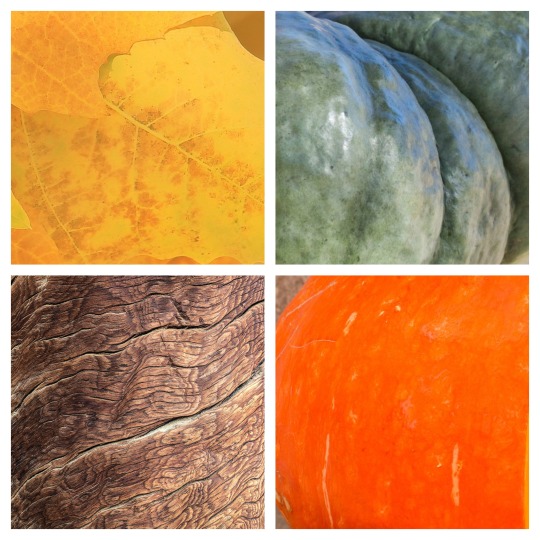
Palette: autumnal green, yellow, orange, and brown.
Notable symbols are the sukkah and the lulav and etrog, but there’s often a lot of autumnal flavor going on here. For a Jewish in-joke, add bees. Bees are always getting into the sukkah.
Simchat Torah
The day after Shmini Atzeret is still a holiday (except in the Reform movement, which combines them into one day). Jewish custom is to read one section of Torah every week, paced so that we read the entire thing in one year. Simchat Torah is the day that we reach the end of the Torah and start again from the beginning.
By “read,” we do not mean in the Protestant sense of just opening an English translation and reading to yourself the words printed inside, though we may also do that on our own time if we wish. The Hebrew words are chanted according to a centuries-old system of musical notation, out of a hand-lettered parchment scroll. The scrolls are treated respectfully: when not in use, they are dressed in rich fabric covers, and often decorated with silver crowns, breastplates, and pointers, and kept in a decorated ark placed prominently at the front (usually east) wall of a synagogue. When the Torah scrolls are removed from and returned to the ark before and after being read, they are carried in procession through the congregation. On any other occasion, one to two scrolls are taken out (a congregation may own several), and three to seven people might be honored with an aliyah (plural, aliyot), the opportunity to speak the blessings before and after the reading.
On Simchat Torah, that procession escalates into seven rounds of dancing. Congregants will take turns holding the scrolls and dancing if they feel able to do so, while the majority of the congregation dances around them in a circle. This can get kind of wild, and in many places adults are also drinking while this is going on. Some synagogues have impromptu (and I’ve even seen professionally staffed) open bars going on. Rather than a few people being honored with aliyot, every Jewish adult present may have an aliyah, and there is a group aliyah for all present children as well. How this worked in the communities where I grew up was that all but one of the torah scrolls would be rolled to the last column and laid out on tables around the room. Six or seven different people would learn the reading and be stationed at the tables, and would read the final few aliyot over and over and over, until everyone had had their aliyah. The remaining torah scroll is rolled to Genesis, and when everyone has heard the last words of the Torah, someone is honored with the aliyah that begins the torah again.
Many synagogues, particularly in the Reform movement, have a tradition of unrolling the torah scroll, either on central tables or held by congregants stationed around the room, and having knowledgeable people such as the rabbi or educated lay people in the community walk along the scroll pointing out familiar points in the story or interesting facts about the text.

Palette: rich, royal shades of purple, blue, red, and gold.
The main visual symbol is the torah scrolls themselves, either dressed in their covers or open to show the words inside, or images of people holding and dancing with the torah.
Simchat Torah is the last of the holidays that fall in the month of Tishrei. The next month is Cheshvan, and there are no holidays or even minor observances that fall during that calendar month.
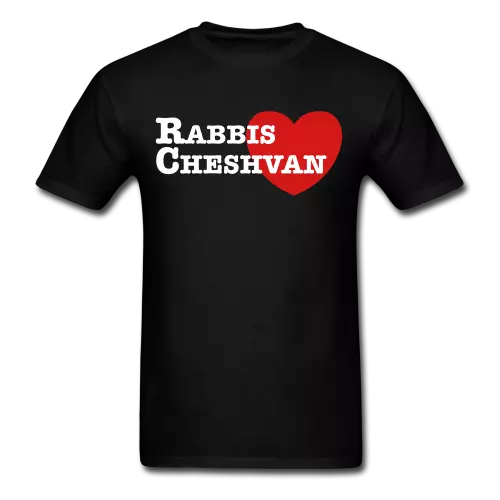
Image: a tee shirt that reads, “Rabbis heart Cheshvan”
Chanukah
Since Chanukah is the most publicized of Jewish holidays, I won’t enumerate the traditions of the holiday. That’s information you can find in other posts. I will note that it’s an eight-day holiday in the month of Kislev (Late November or December) that carries no prohibition on work and is not considered a major holiday in the Jewish calendar. It is not related to Christmas in any way other than occurring at or around around the same time of the year. It is not a holiday about unity, brotherhood, kindness, or gift-giving. It is a defiant and anti-assimilationist holiday commemorating a time when we were threatened with violence unless we gave up our cultural identity and assimilated fully with the majority, a time when the authorities occupied and desecrated our central place of worship and outlawed our customs, and instead of accepting it we rose up and fought, defeating a larger and better-equipped army through guerilla tactics and sheer refusal to give up.
The story of the miracle of the oil was inserted later, when the next people to take over and occupy us wanted to know what we were celebrating. “Oh, don’t worry about it, it’s not about a time when we had a very successful rebellion and ousted a powerful empire, it’s just this one time there was olive oil that...lasted a very long time? Yeah, that sounds good.”
When we light our Chanukah candles, we are encouraged to light them in windows or outside, because this holiday is about reminding everyone else that we’re here, we exist, we will not be made invisible, and we are not going to go away.
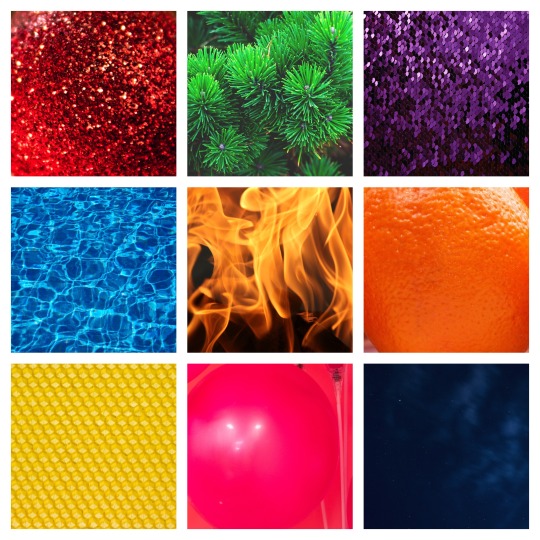
Palette: a rainbow of bright or glittery colors, plus fire.
When people depict Chanukah in the context of Christmas, setting blue in opposition to red makes a certain kind of sense. When I think of Chanukah, though, I think of a rainbow of bright, colorful candles, set in menorahs that can be silver or gold but also ceramic, stone, enamel, rhinestones, glass. Picking out the colors for my own menorah was a nightly joy during Chanukah from the time I was old enough to do my own. Every synagogue and probably every home has just a ton of colorful plastic dreidels that no one ever seems to buy, they just appear. Besides menorahs and dreidels, other symbols are latkes and sufganiyot. That American bakeries haven’t heard of sufganiyot is a heckin’ missed seasonal opportunity for them.
Tu B’Shvat
Tu B’Shvat is another minor holiday with no prohibition on doing work, so feel free to schedule that meeting. It’s referred to as the Birthday of the Trees, but it has taken on a variety of conflicting interpretations throughout history, including a celebration of the Seven Species of agricultural products native to the Middle East, an “earth day” style appreciation of the natural world, and a celebration of the changing of seasons from winter to spring.
This isn’t likely to be anyone’s big get-together-with-the-family holiday; there are often community activities featuring the Seven Species or four cups of wine (usually juice to be honest) where the first is white, the second is white with a drop of red, the third is red with a drop of white, and the last is red. The sequence is intended to acknowledge the coming of spring.
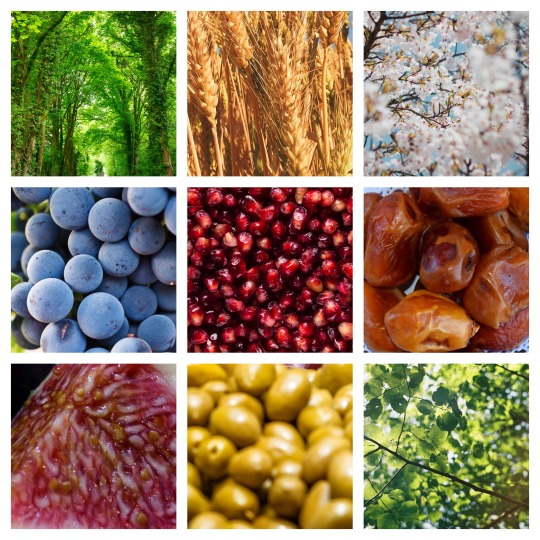
Palette: shades of green, red, purple, brown, and pale pink.
I tried to combine several different takes on the holiday into one palette: green leaves, the Seven Species, and the flowering almond trees mentioned in the best-known song about the holiday. Visual symbols center around trees, especially the flowering almond tree, or the Seven Species.
Purim
People compare Purim to Halloween sometimes, but it probably has more in common with Mardi Gras or Carnival. Falling somewhere in March or April, the holiday commemorates the events of the Book of Esther (Megillat Esther, often simply referred to as The Megillah), in which a modest and beautiful Jewish girl, chosen to be queen in a beauty contest while hiding her culture of origin, must summon the courage to confront her incompetent husband and get him to reverse his anti-semitic vizier’s genocidal decree. Between the theme of hiding her identity and intent, the “topsy-turvy” reversal of fortune at the end of the tale, and the sheer wild absurdity of the story as a whole, the holiday is a festival of silliness and absurdity.
Purim does not carry a prohibition on work, but if you can avoid scheduling something special on that day your Jewish employees or students will be grateful, because Purim festivities at a synagogue are a sad thing to miss out on. The main custom of Purim is to hear the Megillah read aloud. It is read similarly to how the Torah is read: readers chant it out loud according to the ancient musical notation, often switching off at the chapter breaks so that no one person has to learn the whole thing. On Purim, readers will often do funny voices for the characters or give the words hilariously dramatic emphasis--without sacrificing accuracy or melody. At the name of the central villain of the story, listeners shout, stamp, and wave noisemakers to drown out his name.
Additional customs include wearing costumes, alcohol consumption, eating hamantaschen, which are triangular cookies filled with like literally whatever, giving gifts of little snack bags to friends, and giving gifts of money or practical supplies to those in need. To give money is the traditional requirement, but one year my class made a project of doing a toiletries drive ahead of the holiday and packaging their donations into bags to bring to a local shelter. By doing this we were able to bring the shelter something they described as their biggest non-money need, and the kids were able to conceptualize the impact of their giving in a more concrete and hands-on way that will hopefully push them to keep doing good later in life. It’s a project I’d like to do again when I get the chance.
Another tradition is putting on a Purim Shpil, a play that retells the story of Esther while lampooning the community and its leadership. Many communities also hold a carnival on the nearest Sunday morning where kids can play carnival games, jump in a bounce house, run around in their costumes, dunk or pie the rabbi, and more.
Adar, the month in which Purim falls, is considered a month of increased happiness. It’s also the month we repeat on a leap year (yes, the whole month). When Adar repeats, all notable occasions take place in the second Adar, except for birthdays or yahrzeits where the person was born or died on a leap year during First Adar.

Palette: glittery or bright shades of red, green, purple, and orange.
For me Purim’s palette is reminiscent of Mardi Gras, both because of the masked party atmosphere and because of the royal status of the main characters of the story. Symbols include masks, crowns and scepters and other images of royalty (anacronisms welcome on Purim!), the megillah itself, a narrow scroll wrapped around a wooden holder, hamantaschen, and candy.
Passover
Usually falling in April around the time of public schools’ spring break, Passover is the second of the three pilgrimage holidays. Like Sukkot, it is an eight-day holiday where work is prohibited on days 1, 2, 7, and 8 and allowed in between, but given the scale of this holiday your Jewish employees or students would probably appreciate if important things were scheduled for after the holiday instead of in the middle.
The scale of this holiday is...huge. Essentially, we replace our entire kitchens for a week, hiding normal foods, everyday cooking appliances, utensils, pots and pans, covering the counters with foil or contact paper, and swapping out regular tableware for a set that has never come in contact with bread. We absolutely do not eat bread during Passover. Even Jews who don’t go to those lengths to prepare for the holiday, who don’t keep a spare set of dishes or replace all opened containers of food, will at the very least avoid eating bread for the week of the holiday.
For the more observant, “bread” actually means anything leavened with yeast or that has grain (including flour) as an ingredient, except for matzah. Seriously, Gluten-free cooks, search for Passover recipes when you feel like getting ambitious. My mother makes nut flour cakes that rise with the power of an insane number of beaten egg whites. My father makes a pot roast that can make you forget bread ever existed. My mother makes matzah balls out of smashed, soaked matzahs and egg, and a friend of ours makes a “crepe cake” style dessert out of layers of soaked matzahs and caramel sauce. Last year my wife made an insanely delicious dish that combined matzah and eggs with onions and mushrooms and honestly it was spectacular. But we’re all a little relived when we can put the Passover dishes back in the highest cupboard for a year, put our kitchens back to normal, and have a freaking bagel.
This is the holiday where you are absolutely going to travel if you have to to be with family or friends. In 35 years, I’ve only spent one Passover away from my parents, and it was hard. Some families will get together in a rental house or Jewish camp cabin rather than redo their home kitchens and put one family through the work of hosting, but many families have that one matriarch or patriarch who is determined to keep bringing everyone into their home for as long as they can manage the labor.
My mother goes all out. Not only is the kitchen fully changed over and the dining table extended with all its leaves, there’s a second table pushed up to the end of the first one. The seder starts at sunset and ends around 1 to 2 AM.
A seder is not simply a festive meal, like Thanksgiving Dinner. Before we start eating, we sing, recite blessings, pray, read psalms, drink two cups of wine, tell the story of Exodus in about three different ways, throw plastic frogs (okay, the year I landed one in my dad’s wine glass he decreed that we had to stop throwing them, but I’m hoping he’ll forget), recite more blessings, ask around for creative or academic insights, ask newcomers about themselves and invite non-Jews to ask questions about what they’re seeing, crunch a little parsley in salt water, eat a slice of horseradish and weep about it, sing some more, and THEN we can eat dinner. And because everyone’s having a good time, the dinner section can go until 11, and my wife absolutely bails before dessert and goes to sleep on the pull-out couch. After dessert the kids do a scavenger hunt for another piece of matzah, the winner (okay, and the other kids) get presents, and we all start singing again. Two cups of wine later, we’re opening the door for Elijah, loading the dishwasher, too keyed up to go to sleep. Which is fine, go ahead and sleep in tomorrow, because on the second night we do the whole entire thing again.
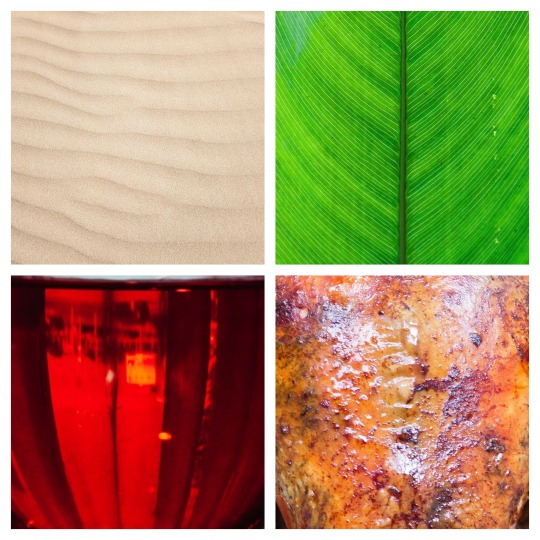
Palette: desert sand, leaf green, wine red, and the brown of roasted food.
Passover comes with a wealth of multivalent symbolism (which is why the seder lasts so long), and the colors of the foods echo the references in the text: the sandy color could be matzah, could be horseradish, could be Egypt or the desert or the path across the floor of the Red Sea. Green could be the parsley dipped in salt water, or it could be springtime. The red could be four cups of wine or the blood in the Nile, and the brown could be dinner, or it could be bricks.
Visual symbols for Passover include: the Seder Plate, which is a large, decorated tray or platter with spaces labeled for the six symbolic foods that we refer to or eat during the seder; a goblet of wine (or four, since we drink wine four times during the seder); pyramids, a reference to Egypt, where the story takes place (despite confusion, the Torah does not state that Hebrew slaves built the pyramids; even if every word of torah were to be considered literal historical truth, the pyramids would still predate this story by centuries); frogs (it’s all about keeping the kids engaged); and, of course, matzah.
Yom HaShoah
I decided to include the modern holidays because they are observed by most contemporary American congregations in at least some way, even though some of them relate specifically to the state of Israel. In doing so, I’m describing the holiday and its observance by American Jews in the United States. I am not Israeli myself, and while I’ll touch on how the holiday looks there, I also haven’t lived there as an adult and can’t really speak to it firsthand. I’m aware that just mentioning the existence of Israel at all is inviting abuse, since there seems to be a prevailing opinion on both sides that every mention of Israel must either be unquestioningly pro-Netanyahu or unquestioningly against the existence of the entire country, and that those who believe in that binary will decide for themselves which extreme any mention must belong to and abuse the writer accordingly. I am new to using Tumblr for much, so I don’t know if it’s possible to delete comments, but if I receive abusive comments from anyone I’ll do my best to figure it out.
I’m here to talk about the Jewish calendar, and about color and art.
The first of the modern holidays that fall in late spring isn’t related to the State of Israel: Yom HaShoah is a day of remembrance of the Holocaust. As a modern holiday, it does not carry any work prohibition, so if you have to schedule something for that day go ahead, just like maybe don’t go making any Nazi jokes? I mean, those are baseline unfunny, but today it’s likely to be a little more raw.
Synagogues tend to hold a short service at which memorial candles will likely be lit, and survivors in the community are invited to tell their stories. There may also be a push to get involved with efforts to preserve the stories of survivors before they are gone, or to oppose genocides currently taking place around the world. Depending on the political skew of the congregation, this could mean a variety of things.

Palette: brick red, black, white, and yellow.
Yellow and black for the stars Jews were forced to wear sewn to their clothes so they would be easily identified (despite the insistence that Jews look a certain way). Brick for the places where Jews and others were held, and were killed. White for the reminder that of the generation who lived it, those who are still with us are aging, and what they witnessed will soon only be known of, not remembered.
Tattered yellow stars with the German word “Jude” and images of barbed wire are the dominant symbols of this holiday.
Yom HaZikaron
Israel’s Memorial Day isn’t really observed with much intensity by American Jews. Those who have lost a friend or family member who served in the Israeli armed forces might observe privately, and people who are passionate about Israeli affairs might organize a talk or documentary viewing on that day, but unless it lands on a weekend there’s not likely to be a notable observance. This is again a modern holiday that carries no prohibition on work.
It’s worth mentioning, though, that while in America our Memorial Day is only observed with solemnity by people who have served themselves or were close with a veteran who has passed away, in Israel that is literally everybody. Since service is mandatory for all* young adults, and has been for generations, everyone knows someone who has been lost. The entire region is bathed in blood, and probably always will be.
*there are exemptions, such as for the extreme Ultra-Orthodox, but as I understand it Disabled Israelis do serve, as do many Israeli non-Jews.

Palette: Black, flame orange, white, blue.
For this holiday I combined the blue and white of the Israeli flag with solemn black and orange for the flame of memorial candles. Black isn’t really a mourning color in Judaism (we don’t necessarily wear it to funerals or anything), but to an American eye it definitely speaks of solemnity and loss. To a Jewish eye, the image of a yahrzeit candle gives the same feeling.
Yom Ha’atzma’ut
This. This is the holiday where the palette is actually blue and white. Israel’s Independence Day is the day after Israel’s Memorial Day. The country goes from an atmosphere of sincere mourning to a cathartic party. I haven’t been in Israel during this time except for once as a small child, so I can’t report firsthand on what it’s like, I can only speak to how it goes in American Jewish communities.
This can vary by a lot, depending on the community’s politics and aesthetic. There is again no prohibition on work. Some places will have Israeli folk dance performances or lessons. Some places will serve Middle Eastern food or invite Israeli members of the community to speak. Some places might watch Israeli movies. There’s no real established practice, it’s just a cultural celebration.
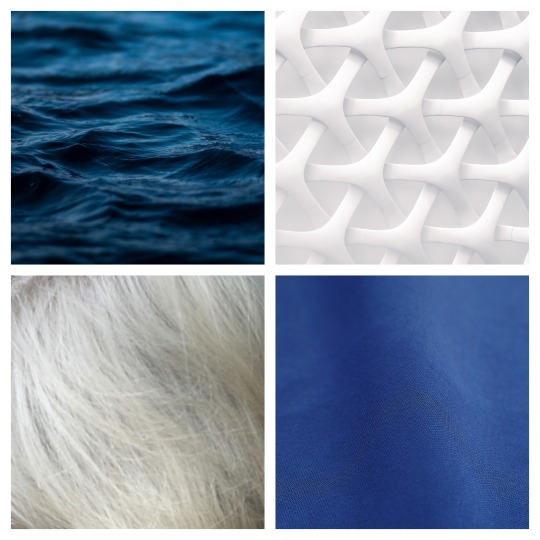
Palette: shades of white and blue.
For making this palette I could have just gone with royal blue and pure white, but I picked textured images that speak to the many sides of a very complicated country. One of the white images is a futuristic pattern of plasticky fibers. The other is an elder’s white hair. One of the blues is soft, comfortable fabric, and the other is a choppy sea. Israel is a lot of things simultaneously, and even in making a palette of two colors I couldn’t manage to reduce it to any two ideas. What I’ve noticed about Tumblr is that for some people, it can be a great place to turn over and over the deeper and more difficult facets of a situation with multiple contradictory facts. For others, it can be a forum to angrily battle down the discomfort of uncertainty by declaring anything difficult to be false, and anything challenging to be simple. If you’ve come this far in this post, I hope you choose the former.
Shavuot
The third of the three pilgrimage holidays falls late enough in the year that Hebrew schools often struggle to teach it, since it falls at or after the end of the school year. It commemorates our ancestors receiving the Torah, and traditions include staying up all night the day before to study Torah and Jewish-related subjects, decorating with flowers, and eating dairy products. Blintzes are a traditional food, but cheesecake is ubiquitous, and ice cream makes an appearance at kids’ activities. Most congregations will hold an all-night study session, sometimes together with other local congregations, where clergy and lay leaders will take turns presenting words of Torah through whatever lens fits their expertise.
Work is prohibited on Shavuot: this is not a good day to schedule that professional conference.
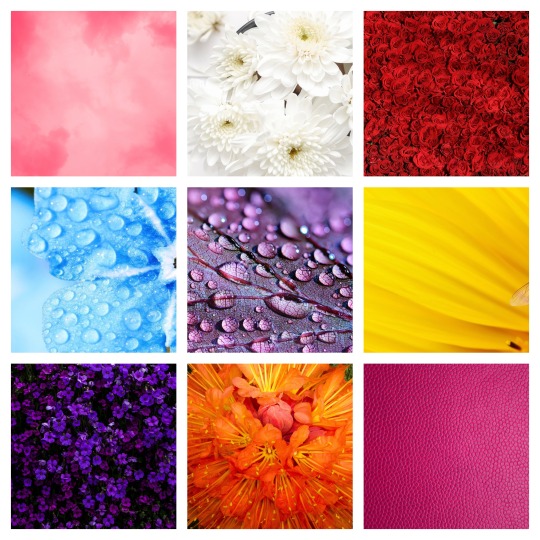
Palette: floral tones of red, blue, pink, purple, white, and orange.
The colors of flowers define the visuals of Shavuot. As a kid we sometimes made flower crowns out of construction paper, and I’d love the chance to lean into this as a craft project for older kids some year combined with words of Torah...when Shavuot next falls within the school year again. Other visual symbols include the Ten Commandments, Mount Sinai, and stalks of wheat, a reference to the Book of Ruth.
Tisha B’Av
Tisha B’Av falls during July-ish and is the designated anniversary of every disaster to befall the Jewish people. It’s the anniversary of the destruction of the central Temple in Jerusalem (both times), but it’s also the anniversary of the first Crusade, of expulsions of the Jews from various European countries in the middle ages, and of various key events of the Holocaust, in modern times. Work is not prohibited on Tisha B’Av, but since Jewish adults who are physically and psychologically able to will be fasting from food and drink that day, it would be kind to avoid scheduling anything strenuous.
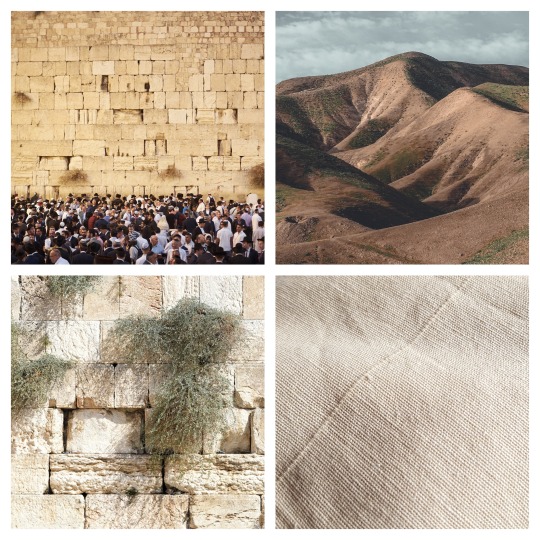
Palette: shades of brown and tan, with hints of green: Jerusalem stone and the scrubby Negev desert.
The iconic image associated with Tisha B’Av is the Western Wall: the destruction of the building that once formed the central focus of our culture, and the associated exile and diaspora, echo throughout the other disasters associated with this day. Even for Jewish communities whose custom is not to hope for a literal rebuilding of the Temple, it speaks to the danger and loss of unity that comes of being outsiders wherever we go, and the longing to return one day to a state of safety and peace.
There are a few minor holidays or holidays only celebrated by certain ethnicities of Jews, which I didn’t create palettes for. If you have suggestions, let me know!
Before ending this post, I’d like to reiterate my request that Christian artists respect that Judaism is not a sect of Christianity. I can’t control what you choose to do with this resource, but if you choose to make Christian or Jesus-related art appropriating Jewish imagery, please be honest: do not claim that you’re doing it out of respect for Jews or Jewish culture, say you’re aware that you’re doing something unwelcome and inappropriate and have chosen to do it anyway.
But if you’ve been wanting to draw Jewish people or characters doing Jewish things beyond just wearing blue to a Christmas party, I hope this post has helped, and I’m happy to field any follow-up questions about Jewish holidays and art.
#Jewishjanuary2020#jewishjanuary#Jewish january#jewish holidays#jewish art#jewish art guide#Meir Makes Stuff#jewish fanart#Rosh Hashanah#Yom Kippur#High Holidays#Sukkot#Simchat Torah#Chanukah#חֲנֻכָּה#Tu Bishvat#Purim#Pesach#Passover#Shavuot#Yom Hashoah#Yom HaZikaron#Yom Haatzmaut#Tisha B'Av#antisemitism mention#Jewish#Judaism#Judaica#Jewish headcanons#Jewish canon characters
2K notes
·
View notes
Text

Day 10: Sukkot!
My favorite holiday!!!! Sukkot is rich in symbolism and history and yet the thing I can’t forget is my Rabbi drawing a gosh darn punnet square as seen above. He has at least 5 different things each object can symbolize and most of that can fit in some sort of punnet square form.
50 notes
·
View notes
Text
Day 3: Shabbat
@jewishjanuary
(i’m considering this a semi-canon outtake for my current project, a ya urban fantasy novel, which you can find in the tag “blood moon” here or on my main, @adhdkirabraginsky. for some quick context: deb and kathy are werewolves, zachariah is a vampire who is training kalli (dryad) and miguel (witch) to be protectors of the magical community, teddy (merman) is miguel's boyfriend, and sierra is the newest member of the team and has just discovered she has a natural affinity for breaking and reversing spells/curses/glamours/etc. also, this takes place near the beginning of june in iowa, hence why shabbat starts so late.)
Sierra was so absorbed in her book that she nearly missed the buzzing of her phone, but luckily, Kalli was a double-texter.
7:20 pm “hey can u come and help me clear the dining rm table??”
7:21 pm “thx in advance btw!!”
She couldn’t think of any reason they’d need the dining room. Since they’d arrived at Deb and Kathy’s on Monday, four days earlier, all seven of them had used the kitchen table for each meal. Given the size of the extended Benson-Caan pack, it was more than up to the challenge. Still, she'd been asked to help, and it was only polite to lend a hand.
The dining room was located near the front of the house, with some lovely bay windows overlooking the farm. Going from the library upstairs to the dining room downstairs took her through the kitchen, and in there, Deb, Zachariah, and Teddy were hard at work on a number of dishes. There was soup on the stove, fresh bread on the counter, and it smelled like chicken as well. Teddy was tossing a salad at the table, which was probably for the best. He was enthusiastic about most things, but, well, not exactly coordinated.
She hung back at the threshold, trying to make sense of the bustle. Deb turned around and spotted her.
“Sierra, love, are you looking for Kalli?”
“Yeah, um, she texted me just now?”
“Good, good, she’s still in the dining room. Can you go and give her these, moyzele?”
Deb handed her two silver candlesticks, a brass one, and three of porcelain, painted in bright swirling blues and greens. On top of this was a box of white taper candles and a book of matches. They were piled carefully in her arms, making sure none of them would fall, and her bewilderment grew.
“Sure thing,” Sierra said, though it was a bit redundant now.
The dining room table had become a bit of a dumping ground for loose papers and projects that Deb and/or Kathy had intended to get to “eventually”. Now it was cleaner than she’d seen it so far, even with about half of it still piled with miscellanea. Kalli was on her way out of the room with an armful of fabric scraps when Sierra stepped in.
“Nice, the fancy candlesticks! You can put those on the table next to the tablecloth. I’ll be back in a second.”
The tablecloth in question was a simple cream color, covered in dark blue lace. Given that the normal one in the kitchen was printed vinyl, this one was definitely a special event sort of tablecloth. Next to it already were two simple glass candlesticks, and Sierra delicately set down the five in her arms. Between the candlesticks and the tablecloth and the food, it was going to be a lovely meal. But for what? It wasn’t any holiday she knew about. If it was Deb and Kathy’s anniversary, surely they’d go into town or something?
“Oh perfect, she found the candlesticks we got in Jerusalem!” Sierra looked up as Kathy and Miguel stepped into the room. Kathy set down a wooden board and an embroidered cloth, and Miguel, a metal basin with a cup in it.
“Which ones are those?” Sierra asked.
“The blue and green ones,” Kathy said, picking one up and smiling. “We went on a second honeymoon after we could get legally married.”
“That’s so sweet,” Sierra sighed. Kathy’s affection for her wife was easy to sink into. Sierra nearly forgot about her earlier confusion. “Um, what are they for though?”
“For Shabbos, of course.” Kathy’s brow furrowed. “Oh, dear. Did no one explain?”
“Explain what?” Kalli asked as she returned.
“Sierra didn’t know that it’s Shabbat tonight,” Miguel piped up. “I’m guessing you didn’t tell her?”
“...Nope.” Kalli’s voice was level but her cheeks were getting redder.
“None of us thought to, either, so don’t go picking on her,” Kathy said. She turned to Sierra and said, “Because Deb and Kalli and I are all Jewish, when we happen to be in the same place on a Friday night, we celebrate Shabbat together. We have a special meal and light candles and enjoy each other’s company. Usually, that includes Zachariah, and recently Miguel and Teddy and their respective families. And tonight, we also have you.”
“Oh,” Sierra said, not for lack of a reaction but an overwhelming multitude of them. It had been a long time since she’d felt this kind of belonging. “Everything in the kitchen smells really good,” she blurted out.
“It is,” Kalli said. “Deb’s lemon-and-thyme chicken is to die for.”
“Alright,” said Kathy. “Let’s get the rest of the table cleared off so Sierra can experience it for herself.”
Between the four of them, it was the work of minutes, and they soon had the tablecloth spread out and all the supplies set up. Kalli and Kathy took turns explaining what each item was for, and Kathy took some long, fond digressions into the personal history of many of them.
“Hot pan coming through,” Zachariah called out, carrying the famous chicken into the dining room. He set it down on a trivet on the table to oohs and aahs. Deb and Teddy followed with the soup and salad, and then Deb doubled back for the bread—the challah, Kalli had explained.
Teddy looked at his watch and exclaimed, “Oh! It’s candle time!”
“Excellent timing, everyone,” Deb said. “Miguel, dear, could you get the basket?”
“On it.” He ducked into the hallway and came back with the basket, which was filled with kippot and kerchiefs. Zachariah, Miguel, Teddy, and Deb each took a kippah and a couple of bobby pins. Kathy and Kalli tied on kerchiefs and Kalli offered the basket to Sierra.
“It’s customary to have your head covered during the candle-lighting and blessings and everything. You can pick whichever one you want.”
She rifled through the basket for a moment until one caught her eye. She tied on the pink-and-white floral, grateful that her hair was in braids and not the Bantu knots that were her other go-to style. That might have been a bit harder to manage. She ran her hand over the kerchief and glanced at Kalli.
“How does it look?”
“Really cute…” Kalli murmured. Her eyes went wide and she looked away. “Uh, d’you want to light one of the candles, too?”
“Sure. Um, just like lighting any other candle, right?”
“Right,” Kalli said. “We light them, cover our eyes, and say the blessings, and then enjoy the lights and our dinner.”
The seven candlesticks, it turned out, were for the seven of them. Deb took out seven new candles and one that had already been used, to light each of the others. They lit the first one and passed it around the table, Deb to Kathy to Kalli to Sierra to Zachariah to Miguel to Teddy.
When they’d all been lit, Sierra watched Kalli, imitating what she did. Still, halfway through the blessing, she couldn’t resist peeking through her fingers at Kalli, taking in the glow on her face from the candles and her inner joy. She really hoped she’d get a lot more Shabbat dinners with Kalli in the future.
7 notes
·
View notes
Text
well I never heard back that #jewishjanuary must be fandom content
I tried to come up with headcanons for jewish characters based on the word strength
but my brain instead fixated on the idea of “jewish” and “strength” together and I wrote a Thing about some important women in my life
(may or may not be poetry. What the hell is a title. Below the cut because it’s long)
there are people I admire
the women around me
my mother
my grandmother
this coworker
.
where does their strength come from?
their persistence in the face of injustice
their commitment to tzedakah
in deed if not in word?
.
I cannot help but compare myself
why am I so lacking?
.
look at this one
working nearly fifty years as an engineer
starting when women were often pressured out of engineering
listen to her telling our creepy coworker that his uncomfortable jokes aren't funny
watch me slip away silently, determined not to give him any more of my free time
watch me eat lunch with most of the team the next day
he is there, as usual
she is not
as usual
listen to her telling everyone "happy new year" in September
despite how none of us respond
not even me
.
when does she eat lunch?
is she lonely?
I wish I could join her
ask about her experiences
as a woman in engineering
as a jewish woman in engineering
as a jewish woman at all
in another life, perhaps I would have been
any of those things
perhaps all of them
before I find a chance to ask
even about lunch
my internship is over
I will never see her again
.
watch me now
biting my tongue the eighth time I am cut off in a meeting in which I am one of two experts
biting my tongue again later that day
when I am praised for learning not to speak over people
"I saw you holding back today"
i had not yet been told it was a problem
they believe I am a woman
I do not correct them
she would not have let them trample her like this
.
listen to that one
repeating over and over
to a cashier we will never see again
the correct pronouns for my wife
usually my wife and I just move on as quickly as possible
in case this is the one ignorant transphobe
that turns out to actually be a murderous transphobe
but there is strength in numbers
he finally calls her ma'am
and we finally leave
my wife admits she appreciated having someone to fight for her
I cannot even fight for my own pronouns
even among friends
when it is just the two of us we resume never correcting anyone
leaving instead of telling them they were wrong
.
And look at the other
kindly but firmly informing someone they got our order wrong
watch me scrape mustard off my burger rather than initiate confrontation
listen to me insist it's okay
it is
really
I’m eating it, see?
.
what makes them similar?
is it that they are all women?
I was raised to be a woman
am I just weak?
or was I taught that women could be strong in this way
and it didn't stick because I am not a woman?
.
perhaps it is generational
perhaps the similarities are coincidence
and my grandmother taught my mother her strength
and my mother tried to teach me
and I have failed to learn
why am I so weak?
.
is it that they are all Jewish?
except
one is not
anymore
but she was raised jewish and I was not
i would like to be jewish
my aunt says I already am
my grandmother says I can be
(christian) society says that religion is defined by belief
I'm not sure I believe in anything
.
perhaps their strength has something to do with being raised jewish
I was not
learning young that you will not be heard unless you shout over the only voice society wants to hear
that your voice has value to others like you
I was raised christian
through no fault of my own
.
I learned to trample others' boundaries
in the name of religion
in the name of helping the very people I was disrespecting
I learned the hard way that my opinions were not welcome
that presenting them so forcefully was rude
I grew out of christianity
I did not grow out of keeping everything to myself
to be polite
I try to never be rude
.
But look now at my rabbi
listen to her introduce herself with her pronouns
every time she stands on the bima to talk
to teach
listen to her call me 'they' without hesitation
hear her offer me an adult b'nei mitzvah
before I am confident enough to ask
watch her navigate conflict with a confident diplomacy
not as a scolding teacher (a call from the principal)
but as a partner in finding peace
the way I aim to do the same
I say I prefer to avoid conflict
but perhaps there is strength in seeking peace
.
my rabbi says I may honestly consider myself jewish
given my ancestry
given my effort to reconnect with my family's traditions
but I also may honestly consider myself not jewish
if I find that to be more true
that I know myself best
and that if I am not trying to lie
about whether or not I am Jewish
then I am not lying
no matter what I say
I can't decide which is more true to me
my participation in jewish community now?
or the lack of formal learning and ceremony
.
my grandmother never had a bat mitzvah either
in her generation
girls didn't get the ceremony
.
Look at all these women around me
these admirable Jewish women
each with their own strengths
I have so many role models to choose from
.
one thing is certain
I aim to be like them:
a Strong
Jewish
...Non-man
#jewishjanuary2020#strength#am writing#jewish feels#poetry#(probably)#autobiographical#a bit scrubbed of detail but mainly because I didn't mention where my coworker (and I) worked yes you would have heard of it#and that's a bit too recognizable for my tastes#this started on the idea of strength and took a years-old identity crisis and brought in a relatively recent resolution#muggle writes#muggle's writing#i forget which tag I use more#muggle originals#anyway obviously there are more important jewish women in my life#but I couldn't describe them all#these are some highlights of people who influenced me#I don't think my coworker I describe here even remembers me at this point#besides vaguely as ''an intern'' if at all#anyway is this poetry or is this choppy prose I'm never sure since I don't make it rhyme#is it poetry because the structure is important to me and specifically that it's not in long blocky paragraphs?#idk#I am the fulfillment of the mother's curse (''may you have a child... just like yourself'') - we both abandoned our mothers' religions#for one essentially incompatible with it#idk I have a lot of feels about that too#listen is anything more jewish than wrestling with the ''am i jewish'' question?#(yes and it's matzoh ball soup)
14 notes
·
View notes
Text
Alrighty. I have some reservations about posting, but I’m going to do it anyway [though, considering those reservations, I may delete these for reivision later]. I probably won’t finish within the January timeline, but I’m going to finish these prompts by the end of the year at least. Because I miss writing Trek fic, and I miss doing some character exploration with Chekov.
So here’s to JewishJanuary [@jewishjanuary] . Day 1: Wonder.
You are the open door that beckons me in; peeking around the door frame, I begin to enter into Your glory. You move me forward, O Eternal, to step beyond self-made boundaries: lift my foot over the threshold that I might abide with You. In the house of the Eternal, I found my questions: waiting to be posed, they filled me with wonder.
As he watches the water passing by, he remembers what it was like to travel as a child. Every Friday, the hour long journey from his hometown to the town across the bay, to visit a tall white building with its tall wooden doors and small metal gate, all lined up along the narrow sidewalk one after the other. He remembers the feeling of being shuffled through the doors, his mother placing a hand on the frame by the mezuzah, his father leading him to the edge of the dark cherry wood benches. He remembers candles burning like the very stars in the sky, light in the dark cold at their edge of the world.
The train stopped just after the park, and he stepped off, glancing between the green trees and the majestic city council building tucked neatly against its corner, a soft yellow with bright orange shingles blazing against the pale blue sky. His father stands beside him, but he is used to the scene - he begins walking, and it is a quiet pacing down the streets before they reach the synagogue.
It is still the same as it always has been: blazing white walls and three entrances. The mezuzah still hangs, neatly fastened to the hidden corner of the frame.
His father beckons, striding through the doors without a second thought, letting his memory guide him. But Pavel pauses, his own memories blurred and muddled. It had been years since he had last stepped in - over a decade, only a child. He had gone to studies when they lived in Mare Imbrium, attended the holiday celebrations in Moscow, held shabbat evenings at his dorm while at the Academy. But space was a challenge, and he had let things slide beneath the waves of learning and charting and survival, letting the stars become his candlelight.
Would he remember the ways of his childhood? Would he remember the prayers that had once felt like the universe singing to him? Would he remember -
“Ah, the youngest Chekov!” A warm hand fell heavy upon his shoulder. An older family friend, of whom he had forgotten the name. “We have missed you greatly! Your father tells us of your adventures - you had stars in your eyes as a kid, and we always knew you’d get lost among them someday! But it’s good to see you have found your way back.”
“Ah. Yes. It is - good to be back,” Pavel answered, polite but still uncertain.
“You’re here, are you not? That is what’s important. Come, come,” the man said, ushering him in. Pavel let himself be carefully taken along; his feet followed, hesitant but slowly gaining ease as they walked the steps once more. They paused before the sanctuary as the man rustled about a small basket. His hand pulled out a dark blue kippah, embroidered around the edges with tiny specks of six pointed stars.
“That’s - “
“Yours, yes.” The man placed it in Pavel’s hands. “You were always very protective of this one - it was your favorite. And in turn, the stars have protected you.”
Viktor. His name was Viktor. An engineer, like Scotty -
“Is that Pavel?” A tall woman walked toward them, beaming. Marya. Viktor’s wife. She would bring them candles, home made, an older art skill that she crafted into a lucrative hobby. Beautiful creations of peeled and curled wax, intricately carved with little hamsa figures along the petals of blues and greens and golds.
“It’s good to see you home,” she said, hugging him tightly. He wrapped his arms around her in return, still clutching the kippah in his hand.
“It’s good to be home.”
#quotes from the reform siddur we have#i have so many pages marked that i'm reflecting on and going back through#so this will be nice as a springboard#jewishjanuary20#star trek#pavel chekov
10 notes
·
View notes
Text
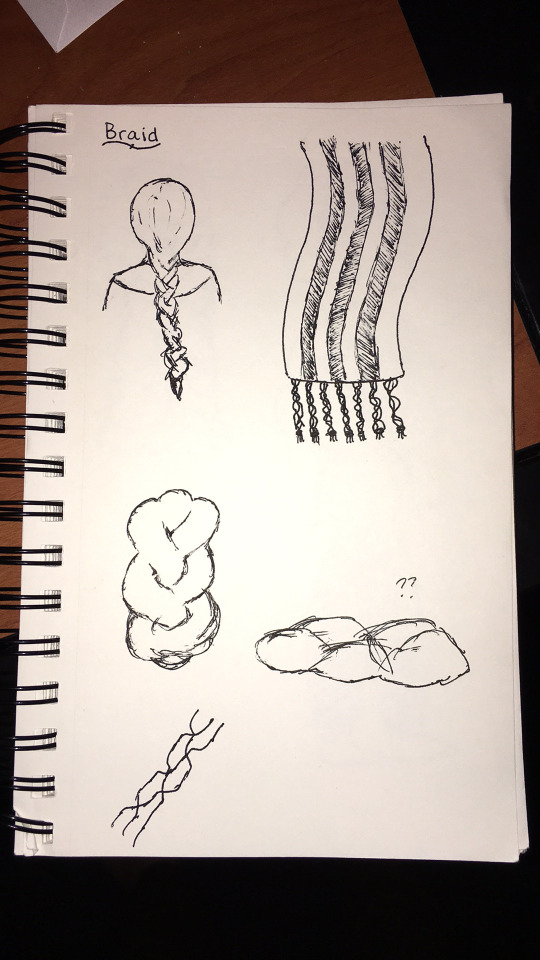
i’m sorry this is late but here is my entry for #jewishjanuary20 !!! @jewishjanuary
5 notes
·
View notes
Text

Day 8: Dance
I was inspired by my favorite musical fiddler on the roof and couldn’t pass up the chance to wood burn a quick silhouette!
#fiddler on the roof#musical#wood burning#my art#pyrography#jewish january#jewishjanuary#jewishjanuary20
37 notes
·
View notes
Text

Day 12: Gay!
33 notes
·
View notes
Text
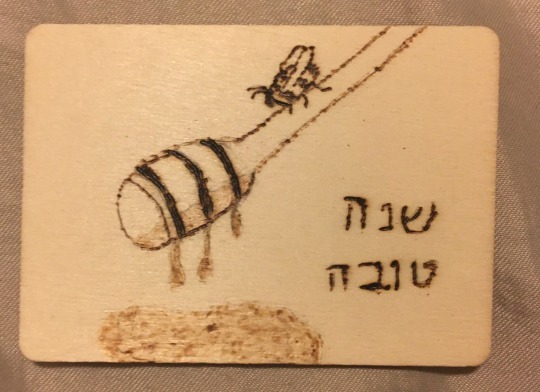
Day 6: Rosh Hashanah
18 notes
·
View notes
Text
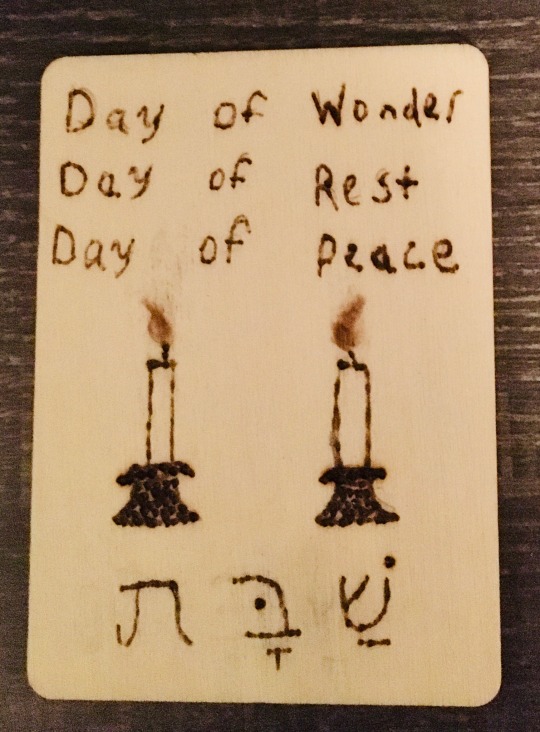
Shabbat Shalom everyone!
I just got started with wood burning and am still learning for sure, but I couldn’t pass up a chance to wood burn for Jewish January!
16 notes
·
View notes
Text
Jewish January Day 5: Journey
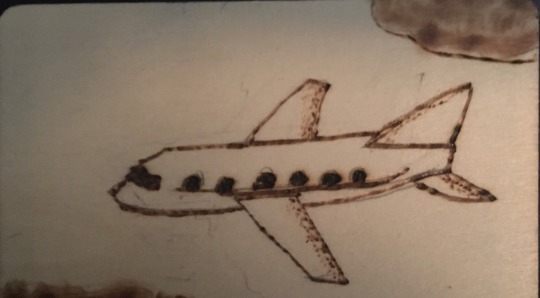
My journey into Judaism all started on a n airplane. This is the story of Howard. I like to say that Howard is the most influential stranger in my life. I met Howard on a short 1 hr plane ride from Indianapolis to Chicago about 6 years ago.
Now, I’ve flown a fair amount in my life, and before meeting Howard the following trend happened on every flight I had ever taken: when flying alone, I always happened to sit either in my own row or next to a very religious or spiritual person. I had sat next to a nun, a monk, 3 catholic priests, a mormon leader, a nondenominational christian pastor, and a few other people that were just very interested in sharing their faith. Note: at no point in my life have I ever prompted a stranger to share their religious views with me on a plane, I always just asked someone what they were reading and it was always something spiritually based leading to a broader conversation.
When I asked Howard what he was reading he told me it was a book about women in the Torah. We got into a conversation about feminism and religion and what his views were. I had never met someone who had such similar views to mine.
After that plane ride when people asked me what I believed in I would tell them that I believed in Howard. Howard had the right idea and was going to make a difference in this world.
Years later I realized that Howard was Jewish and maybe I should look into that. The more I read the more I loved it and really identified with the morals and ideals held in Judaism. Then when I moved I decided that now was the time for me to finally visit a Synagogue.
Strangers can have the largest impacts on our lives and never even know it. My journey started on a plane with a stranger, and I will forever be grateful that I met Howard.
15 notes
·
View notes
Text
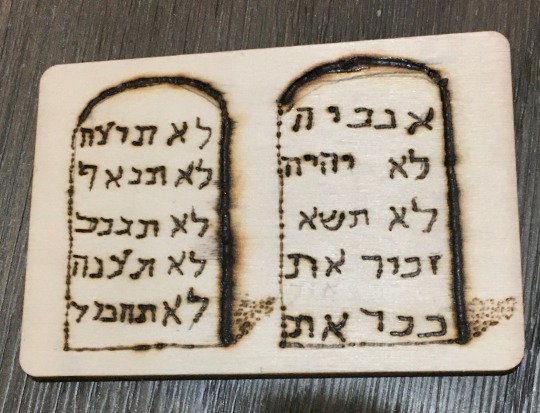
Day 11: Mountain
From Mount Sinai to now I hope you had a lovely Shabbat.
13 notes
·
View notes
Text

Day 13: Janice
My absolute favorite Chanukah memory is trying to play dreidels with my friends and it just devolved into BATTLE DREIDELS. 10/10 would recommend. Winner take the gelt.
12 notes
·
View notes
Text
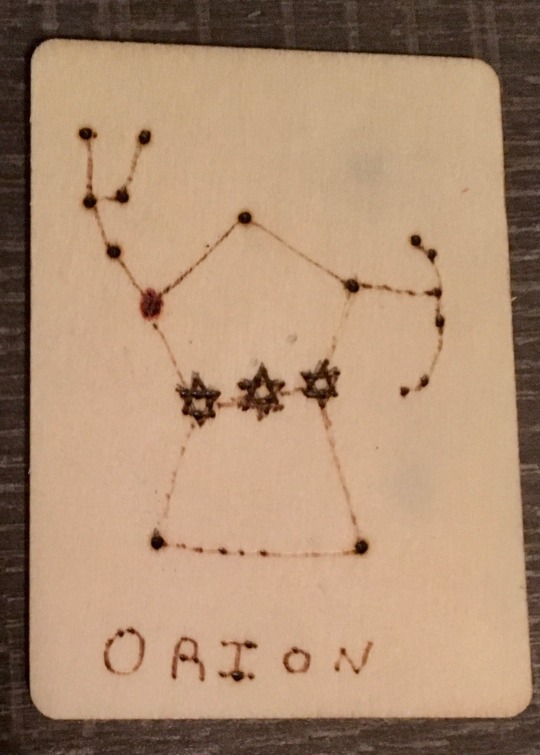
Jewish January Day 4: Stars
Yesterday on my way to Synagogue, I was listening to the radio and they were talking about how the star Betelgeuse has recently faded significantly indicating that it may be near end of life. When it dies it will explode and will likely appear as bright as the moon in our sky
Betelgeuse is often one of the brightest stars in our night sky and also happens to be a part of the Orion constellation which inspired my wood burning for today’s Jewish January. (Betelgeuse is the large kind of redish star located in Orion’s shoulder)
I made the 3 stars of Orion’s belt as Magen Davids to symbolize the 3 stars visible in the night sky signaling the end of Shabbat.
9 notes
·
View notes
Text

Day 9: Braid
Oneg is one of my favorite parts of services. I love going and tearing the challah with everyone. I look forward to one day baking my own challah.
6 notes
·
View notes
Text

Day 14: Reflection
The month if Elul is a time for Reflection and Teshuva. It’s probably one of the hardest things to do...
5 notes
·
View notes